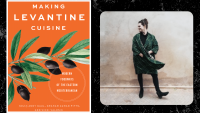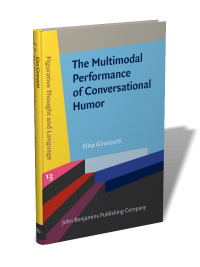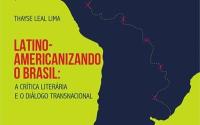SLA Students Shine at AAAL Conference in Texas
Discover the research presented by our students and faculty at the 2024 American Association for Applied Linguistics (AAAL) conference in Houston, TX.


Research in the School of Languages, Literatures and Cultures is interdisciplinary and vibrant.
Faculty and graduate students pursue research in numerous fields of study.
Alexandre Dumas' 1848 novella, La Femme au Collier de Velours belongs to a centuries-old lineage of narratives about a young man courting a mysterious woman who conceals a fatal neck wound. Over the first half of the nineteenth century, this narrative template, now featuring a guillotined woman, becomes a relatively popular device for reflecting on the events of the Terror and its lingering presence in the French and wider European cultural imaginary, even and especially for those born too late to actually witness them. In this article, I trace developments and embellishments in the guillotined woman narrative from Washington Irving's "The Adventure of the German Student" (1824) through Dumas' novella. I argue that the self conscious repetition of this narrative both amplifies and ironizes the masculine anxieties it evokes. Through constant recirculation and reanimation, the guillotined woman becomes both a figure for the uncannily restored monarchy and an allegory of degraded cultural production.
Read More about Loving the Guillotined Woman from Washington Irving to Alexandre Dumas

Between the 1880s and the 1950s, a new genre of cookbooks appeared in Egypt. Largely written by women, these texts addressed the housewives of Egypt’s expanding middle classes. This essay describes how the genre’s authors instructed women to nourish the nascent Egyptian nation. In prescribing specific flavors to notions of “good taste,” these cookbooks’ eclectic combinations of recipes oriented Egyptian readers towards Europe and the Arab East, rather than towards the rest of the African continent. This analysis situates these cookbooks within the overlapping spheres of Egyptian rule in Sudan, the British occupation of Egypt and Sudan, and anticolonial nationalism. It argues that studying gendered and domestic forms of labor, like cooking, can enrich our understandings of how national identity formation hinges on the construction of racial, ethnic, and class hierarchies. Cookbooks thus offer a unique perspective on the relationships between nation, empire, gender, and race.

This volume is the first monograph exploring the functions of visual cues in humor, advocating for the development of a non-linguocentric theory of humor performance. It analyzes a corpus of dyadic, face-to-face interactions in Spanish and English to study the relationship between humor, smiling, and gaze, and shows how, by focusing on these elements, it is possible to shed light on the “unsaid” of conversations. In the book, the humorous framing of an utterance is shown to be negotiated and co-constructed dialogically and multimodally, through changes and patterns of smiling synchronicity, smiling intensity, and eye movements. The study also analyzes the multimodal features of failed humor and proposes a new categorization from a dialogic perspective. Because of its interdisciplinary approach, which includes facial expression analysis and eye-tracking, this book is relevant to humor researchers as well as scholars in social and behavioral sciences interested in multimodality and embodied cognition.
The carnivalesque poetics of the “rogue lyrics” (qalandariyyāt) of medieval Sufi poetry have excited the interest of varied audiences since premodern times. This attention is not surprising: these poems' purported celebration of proscribed actions, antinomian figures, and even apostasy shocks readers and demands interpretation. Many Sufi interpreters, followed by a substantial group of contemporary scholars, have read the carnivalesque imagery of such poetry as an esoteric symbolic code that must be explicated through the Sufi hermeneutic tradition. Other scholars, largely approaching these poems from the perspective of the history of Sufism, have sought to understand this poetry’s relationship with the historical antinomian groups of the medieval Islamic world. What has been lost in these discussions, however, is an understanding of the qalandariyyāt’s poetics and its function within the larger early Persian genre system. This study focuses on elucidating the “poetics of the Sufi carnival” through an exploration of how the qalandariyyāt constructs its heterotopic poetics in its parody of ascetic-homiletic (zuhdiyyāt-mawʿiẓa) and panegyric (madḥiyyāt) poetry. The qalandariyyāt operates as a countergenre, but not in the singular. Subsumed under this broad generic umbrella are multiple subgenres—a point that also illustrates the considerable complexity and historical specificity of the early Persian genre system.
Historical treatments of the “rogue lyrics” (qalandariyyāt) of medieval Persian poetry typically identify their origin in the Sufi poetry of Bābā Tāher, Abu Saʿid, and Sanāʾi and portray them as a poetic instantiation of the intellectual and antinomian critiques of the formalistic modes of piety practiced in the increasingly powerful institutionalized Sufi orders. However, the qalandari panegyrics of the Saljuq court poets Borhāni and Amir Moʿezzi—arguably the earliest datable examples of this poetry—analyzed in this article complicate this narrative. They utilize the heterotopic poetics of the qalandariyyāt not to subvert or critique, but rather to augment the sociopolitical authority of the ruler of Qazvin, constructing a new and distinctly Saljuq model of Islamic kingship, a Qalandar King.
Cette contribution porte sur une histoire de chiens… Ou plutôt deux histoires, celles que Charles Nodier soumet pour le recueil collectif Nouvelles vieilles et nouvelles qu’il copublie avec Toppfer, le comte de Peyronnet et le baron Dudley en 1843. La première a pour titre « Les Aveugles de Chamouny », et pour sujet les amours de deux jeunes gens rapprochés par une infirmité commune avant d’être séparés par une malencontreuse guérison. Le chien en question, un épagneul nommé Puck, y tient le rôle d’adjuvant et témoigne à son maître un amour et une loyauté exceptionnels puisqu’ils finissent par lui coûter la vie. La seconde histoire, aux accents folkloriques démarqués de Perrault, est intitulée « Histoire du chien de Brisquet », et porte sur le courage d’une chienne qui trouve la mort en sauvant les enfants de son maître de l’attaque d’un loup.
Traditionally, the definition of political cinema assumes a relationship between cinema and politics. In contrast to this view, author Mauro Resmini sees this relationship as an impasse. To illustrate this theory, Resmini turns to Italian cinema to explore how films have reinvented the link between popular art and radical politics in Italy from 1968 to the early 1980s, a period of intense political and cultural struggles also known as the long ’68.
Italian Political Cinema conjures a multifaceted, complex portrayal of Italian society. Centered on emblematic figures in Italian cinema, it maps the currents of antagonism and repression that defined this period in the country’s history. Resmini explores how film imagined the possibilities, obstacles, and pitfalls that characterized the Italian long ’68 as a moment of crisis and transition. From workerism to autonomist Marxism to feminism, this book further expands the debate on political cinema with a critical interpretation of influential texts, some of which are currently only available in Italian.
A comprehensive and novel redefinition of political film, Italian Political Cinema introduces its audience to lesser-known directors alongside greats such as Pasolini, Bertolucci, Antonioni, and Bellocchio. Resmini offers access to untranslated work in Italian philosophy, political theory, and film theory, and forcefully advocates for the continued artistic and political relevance of these films in our time.
Read More about Italian Political Cinema | Figures of the Long ’68
Contribution to the digital repository for innovative curricular and pedagogical initiatives in MLA fields: a digital edition of the first seven portraits of the series of "Contemporary Portraits" (1858-1859) published in Le Figaro, a non-political weekly newspaper, by Gabrielle Anna de Cisternes de Coutiras, under the pseudonym Jacques Reynaud. This project, produced in collaboration with Clara Danos, Marie Laverdiere, Michaëlle Vilmont (master's students) and Theavy Din, Charlotte Joublot-Ferré, Madeline Muravchik (doctoral students ), is the outcome of a digital humanities practicum co-taught with Raffaele Viglianti, researcher at the Maryland State Center for Digital Humanities (MITH), as part of the graduate seminar "FREN659: Literature and the Press in the 19th century: a return to the civilization of the newspaper in the digital age" (Fall 2021, University of Maryland).
Kiessling, Benjamin & Kurin, Gennady & Miller, Matthew Thomas & Smail, Kader
This work presents an accuracy study of the open source OCR engine, Kraken, on the leading Arabic scholarly journal, al-Abhath. In contrast with other commercially available OCR engines, Kraken is shown to be capable of producing highly accurate Arabic-script OCR. The study also assesses the relative accuracy of typeface-specific and generalized models on the al-Abhath data and provides a microanalysis of the “error instances” and the contextual features that may have contributed to OCR misrecognition. Building on this analysis, the paper argues that Arabic-script OCR can be significantly improved through (1) a more systematic approach to training data production, and (2) the development of key technological components, especially multi-language models and improved line segmentation and layout analysis.
Read More about Advances and Limitations in Open Source Arabic-Script OCR

This work explores the integration of Brazil within the Latin American cultural and literary paradigm of the 1960s, 70s and 80s. The project centers on the intellectual work of Antonio Candido, Ángel Rama, Emir Rodríguez Monegal e Haroldo de Campos.